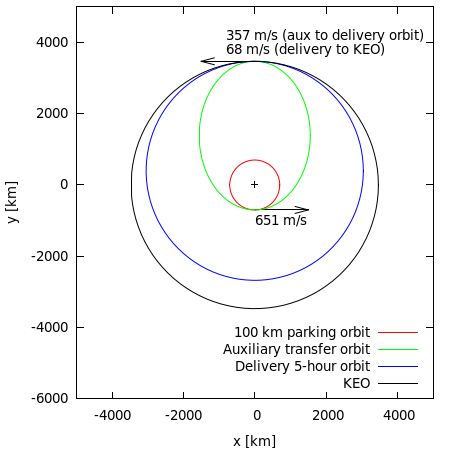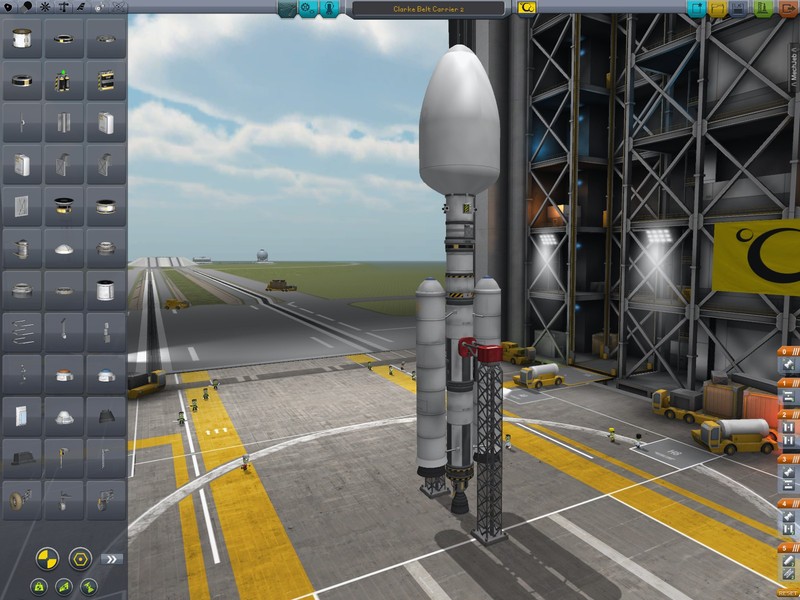The Clarke Ring Mission
Deploying a constellation of satellites to the keostationary orbit
The keostationary orbit is a circular keosynchronous equatorial orbit (KEO) -- that is, an equatorial circular orbit with an orbital period exactly equal to Kerbin's rotation period of 6 hours, which occurs at an altitude of 2868.75 km. The consequence of this is that a satellite in this orbit will seem to remain stationary directly above a point on the surface. This is ideal for communication satellites, since satellite antennas on the ground can be pointed at a fixed point in the sky and don't have to be re-oriented as the planet and satellite rotate.
As part of the Program's commercial application division, engineers were tasked to deploy a network of communication satellites to keostationary orbit. As 5 satellites is the minimum for the satellite network to still be able to provide coverage anywhere on Kerbin if one of the satellites fails, it was decided that deploying a ring of 6 satellites would provide a comfortable level of redundancy.
Putting a single satellite in keostationary orbit is easy, but putting six equally-spaced satellites is harder if they are launched separately, for then each launch and maneuvering to KEO has to be timed very precisely so that the satellite arrives at the keostationary orbit at exactly the right position.
A clever solution is to use a single carrier rocket with all six satellites on board and put the carrier in a 5-hour orbit with an apoapsis at the KEO altitude. Then, the procedure is as follows:
- At first apoapsis passage, deploy the first satellite.
- Have the satellite raise its periapsis to establish keostationary 6-hour orbit.
- At next apoapsis passage, deploy the second satellite. Since this occurs 5 hours after the firt was deployed, the carrier rocket is one hour ahead of the first satellite. It is thus deployed 60° ahead of the first.
- Have the second satellite establish keostationary orbit.
- Repeat the process for the rest of the satellites.
The following diagram shows the required orbital operations and associated delta-v costs (assuming an initial 100 km parking orbit):

The blue orbit is the 5-hour delivery orbit. At each apoapsis passage, the carrier deploys a satellite.
Since the keostationary orbit is also called the Clarke orbit, the mission was called the Clark Ring Mission, and its stated objective and mission details were:
- Clarke Ring Mission
- Primary Objective:
- Deploying six equally-spaced communication satellites to the keostationary orbit.
- Craft Details:
- Satellite mass: 270 kg (each)
- Satellite Δv: 753 m/s
- Total payload: 1620 kg
- Carrier mass:
- Carrier Δv: (carrying six satellites)
- Total launch mass:
- Delivery Orbit Details:
- Period: 5 hours
- Apoapsis altitude: 2868.75 km
- Periapsis altitude: 2074.75 km
- Δv to KEO: 67.46 m/s
- Auxiliary Transfer Orbit Details:
- Transfer from 100 km circular parking orbit to delivery orbit
- Apoapsis altitude: 2868.75 km
- Periapsis altitude: 100 km
- Δv from parking orbit: 651.44 m/s
- Δv to delivery orbit: 356.82 m/s
- Total Δv: 1008.26 m/s
The carrier vessel is a simple rocket with a mounting rig for the satellites and enough fuel to take them to the delivery orbit:
This mission was to first to use the new custom-made payload fairings.
The satellites themselves —standard-design reconaissance satellites retrofitted with communications equipment— had to be closely packed in order to reduces the payload cross-sectional area. Each satellited carried an advanced flight and guidance computer to make sure they reach the keosynchronous orbit with great precision.
Finally, the launch rocket was composed of a single launch stage boosted by solid fuel rockets:
Continue to Phase 1 ...
Phase 1 >


